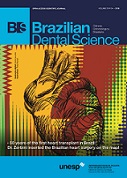Morphological evaluation of temporo-mandibular joint in indian population
DOI:
https://doi.org/10.14295/bds.2018.v21i1.1488Resumen
The temporomandibular joint (TMJ) is one of the most complex joints in the body and its harmonious functioning is very important to maintain a normal masticatory system. The morphologic alterations and the asymmetrical position of the TMJ structures may lead the various clinicalsigns & symptoms. Morphology of the temporomandibular joint may be influenced by gender of patients, environmental factor and also food habits at various places. Objective: To evaluate the morphology of the temporomandibular joint using computed tomography, in order to determine the condyle shape, joint space and glenoid fossa roof thickness. Material and Methods: One hundred and six healthy patients (212 TMJs) who visited a private hospital (or the University’s Hospital) for CT brain scan were included to this cross-sectional study sample.The patients were aged between 20–50 years with an average age of 35.46 years. All the images were taken by positioning patients in supine position with 120kvp , 50ma,2.33minute exposure with 0.7mm thick slicesby computed topography machine in all three projection that is Axial, Coronal and Saggital view. Results: For all variables, the mean and standard deviation were calculated, based on gender, and TMJ sides. The Paired t-test was used and P<0.05 will be considered to be significant. Conclusion: Present study showed that thereis positive evidence of temporomandibular joint involvement in elderly patients. Change in morphology and position of condylar head with glenoid fossa and roof thickness are one of the most common cause of degenerative diseases.
Keywords
Temporomandibular joint; Morphology; Condyle; Joint space.
Keywords
Temporomandibular joint; Morphology; Condyle; Joint space
Descargas
Descargas
Archivos adicionales
Publicado
Cómo citar
Número
Sección
Licencia
Brazilian Dental Science uses the Creative Commons (CC-BY 4.0) license, thus preserving the integrity of articles in an open access environment. The journal allows the author to retain publishing rights without restrictions.
=================
COPYRIGHT TRANSFER AND RESPONSIBILITY STATEMENT
(PDF)
For all articles published in the BDS journal, copyright is retained by the authors. Articles are licensed under an open-access Creative Commons CC BY 4.0 license, meaning that anyone may download and read the paper for free. In addition, the article may be reused and quoted, provided that the original published version is cited. These conditions allow for maximum use and exposure of the work while ensuring that the authors receive proper credit. All metadata associated with published articles is released under the Creative Commons CC0 Universal Public Domain Dedication.
Before the submission, authors must obtain permission to reproduce any published material (figures, schemes, tables, or any extract of a text) that does not fall into the public domain or for which they do not hold the copyright. Permission should be requested by the authors from the copyright holder (usually the Publisher, please refer to the imprint of the individual publications to identify the copyright holder).
The authors hereby attest that the study is original and does not present manipulated data, fraud, or plagiarism. All names listed made a significant scientific contribution to the study, are aware of the presented data, and agree with the final version of the manuscript. They assume complete responsibility for the ethical aspects of the study.
This text must be printed and signed by all authors. The scanned version should be submitted as supplemental file during the submission process.




























